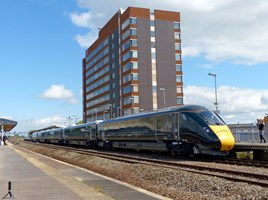The ability of Great Western Railway’s Class 800 bi-mode electric multiple units to meet current and future timetables is under scrutiny by the train operator, due to their maximum speed in diesel mode of 100mph.
Network Rail’s electrification of the Great Western Main Line is taking place on a discontinuous basis, and the trains will have to run on diesel power between energised sections at potentially lower maximum speeds than the current High Speed Trains, which can operate at up to 125mph.
However, uncertainty about exactly which sections will go live (and when) means that planning future timetables when the fleet begins entering service from next year is proving extremely difficult. The Class 802s have a design speed of 125mph under electric traction.
- For more on this, read RAIL 808, published today.
- To read more on this, read The Fare Dealer in RAIL 809, published September 21.















Comment as guest
Comments
BigTone - 31/08/2016 10:51
I think you mean the Class 802's have a design speed of 125 mph in diesel mode. Would it be better to have 802's on the GWR and send the 800's to the ECML then when the GW electrification is nearly finished, send the surplus 802's to Transpennine and Hull Trains?
Reply as guest
Andrewjgwilt1989 - 31/08/2016 11:15
Both the GWML and ECML are 125mph and the Hitachi Class 800's, Class 801's and Class 802's IEP's can actually reach up to 125mph either on electric or diesel as they are bi-mode trains.
Reply as guest
BigTone - 31/08/2016 12:51
Actually, in electric modethey can all do 140 mph (but only with in cab signalling otherwise its 125 mph) The Class 800's s are only rated for 100 mph in DIESEL mode, the Class 802's are rated for 125 mph in diesel mode as they have more powerfull engines (940hp as opposed to 750hp,)
Reply as guest
BigTone - 31/08/2016 20:37
Also, the Class 801 is to all intents and purposes, a straight electric train. I know it has a single engine of 750 hp but that is not meant to be used in general service. The engine has 3 jobs, (1) To run from the last station to the maintainence depot, overhead wires not required. (2) To limp to the next station in an emergency (3) To maintain "hotel services" eg lighting and air conditioning I cannot see a single 750 hp engine drag 9 coaches at 125 mph
Reply as guest
David - 05/09/2016 16:54
Just thought I'd point out that the GWR Class 801s are now going to be bi-mode rather than 'pure' electric owing to the delays in electrification works. All Class 80x trains use the same engine pack, the difference is that they are downrated on the original Class 800 and 801.
Reply as guest
BigTone - 05/09/2016 18:41
You are right David. The 800 and 802 diesels are the same lump, just a different state of tune. I read somewhere that the 801's were to be built as 802's as they have more power and bigger fuel tanks
Reply as guest
BigTone - 12/09/2016 20:53
Another point, the 5 coach Class 800's will be extending the Kings Cross to Newark trains to Lincoln which is not wired and has a top speed limit of 75 mph (although there is talk of raising that to 90 mph)
Reply as guest
FrankH - 31/08/2016 23:01
Turning into a right farce, only here could it be so much money be spent on disorganised chaos. The drivers are going to get plenty of practice going diesel to electric and back. Probably wear the panto raising gear out before full electric running starts.
Reply as guest